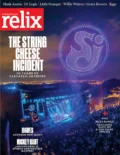Eagle Vision 30243-9
Few bands, if any, have ever produced such a landmark debut as The Doors’ self-titled album. When it was released in 1967, no one had ever heard anything like it. The wild, improv-heavy combination of blues, jazz, funk, rock, and German schlager music, all filtered through an acid-tinged lens, was quite unique at the time. And then there was Jim Morrison, the howling shaman with his poetic lyrics that evoked images of darkness, destruction, and chaos. While the San Francisco psychedelic scene was advocating peace, love, and happiness, Morrison and his Venice Beach mates were advertising something completely different. Upon hearing this coming-of-age record, an entire generation was suddenly inspired to investigate philosophy and question authority, and this effect was not limited to the fans of 1967, as this album continues to change the course of new listeners’ lives to this very day. I know because I speak from experience.
The Classic Albums series gives us the back-story and juicy details that fans crave. Here we get to listen to The Doors’ original acetate demo for “End of the Night,” a creepy recording that won them an initial contract with Columbia Records, but when Columbia’s producers refused to record the band, they were released from the deal, and after seeing them for the fourth time at the infamous Whisky-a-Go-Go, Elektra Records’ Jac Holzman immediately signed them. We also learn that Morrison used to remember his lyrics by making up little melodies. Even though he had no musical training, the band members recognized brilliance in these melodies, and they would set about transcribing them and building soon-to-be-iconic songs around these melodic bases. We also get plenty of dirt on Morrison, who was rather into LSD at the time and occasionally prone to break into the studio and freak out or just throw a television set at the recording studio window in the middle of a session.
The real pi de rstance of this release occurs when engineer Bruce Botnick begins fiddling with the multi-track recordings, and the band talks about how they developed these songs. As Botnick raises and lowers the levels on “Break on Through,” drummer John Densmore demonstrates how he developed a deconstructed bossa nova backbeat, while organist Ray Manzarek shows how he stole his riff from Ray Charles’ “What’d I Say,” and guitarist Robbie Krieger reveals how he thieved his riff from the Butterfield Blues Band’s “Shake Your Moneymaker.” Of course, Botnick takes delight in playing Morrison’s “She gets high” lyrics, which had to be excised in order to release the album. On “Soul Kitchen,” Krieger displays how he was emulating James Brown, we learn how bassist Larry Knetchel was brought on board to add more beef to the bottom end, and we also hear Densmore’s overdubbed second drum track, one of the few times the band used overdubs on this record.
By the time they had entered the studio, The Doors had been solidly writing and performing for one-and-a-half years. With over 30 songs under their belt, they were primed to create this legendary debut album, and this DVD does an excellent job of breaking down the intricacies of their writing and recording process, along with revealing the many amusing and fascinating stories that accompanied a character like Jim Morrison. The DVD is chock-full of great extras, but none is more powerful than Ray Manzarek sitting down at a keyboard, re-enacting Morrison’s now classic, improvised Oedipal performance of “The End” at the Whisky. The event that got the band booted from the venue was fundamental in forming this epic song, a number that was unlike anything heard at the time (or even since) and a chief reason why The Doors is most definitely a classic album.


No Comments comments associated with this post